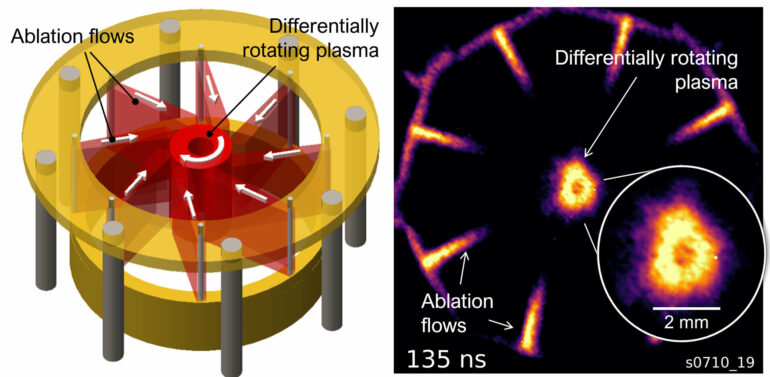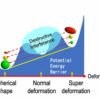Imperial College researchers have created a spinning disk of plasma in a lab, mimicking disks found around black holes and forming stars.
The experiment more accurately models what happens in these plasma disks, which could help researchers discover how black holes grow and how collapsing matter forms stars.
As matter approaches black holes it heats up, becoming plasma—a fourth state of matter consisting of charged ions and free electrons. It also begins to rotate, in a structure called an accretion disk. The rotation causes a centrifugal force pushing the plasma outwards, which is balanced by the gravity of the black hole pulling it in.
These glowing rings of orbiting plasma pose a problem—how does a black hole grow if the material is stuck in orbit rather than falling into the hole? The leading theory is that instabilities in magnetic fields in the plasma cause friction, causing it to lose energy and fall into the black hole.
The primary way of testing this has been using liquid metals that can be spun, and seeing what happens when magnetic fields are applied. However, as the metals must be contained within pipes, they are not a true representation of free-flowing plasma.
Now, researchers at Imperial have used their Mega Ampere Generator for Plasma Implosion Experiments machine (MAGPIE) to spin plasma in a more accurate representation of accretion disks. Details of the experiment are published May 12 in the journal Physical Review Letters.
Accelerating plasma
First author Dr. Vicente Valenzuela-Villaseca completed the study during his Ph.D. in the Department of Physics at Imperial. He said, “Understanding how accretion disks behave will not only help us reveal how black holes grow, but also how gas clouds collapse to form stars, and even how we might be able to better create our own stars by understanding the stability of plasmas in fusion experiments.”
The team used the MAGPIE machine to accelerate eight plasma jets and collide them, forming a spinning column. They discovered that the closer to the inside of the spinning ring was moving faster, which is an important characteristic of accretion disks in the universe.
MAGPIE produces short pulses of plasma, meaning only around one rotation of the disk was possible. However, this proof-of-concept experiment shows how the number of rotations could be increased with longer pulses, allowing better characterization of the disk’s properties. A longer experiment run time would also allow magnetic fields to be applied, to test their influence on the friction of the system.
Dr. Valenzuela-Villaseca said, “We are just as the start of being able to look at these accretion disks in whole new ways, which include our experiments and snapshots of black holes with the Event Horizon Telescope. These will allow us to test our theories and see if they match astronomical observations.”
More information:
V. Valenzuela-Villaseca et al, Characterization of Quasi-Keplerian, Differentially Rotating, Free-Boundary Laboratory Plasmas, Physical Review Letters (2023). DOI: 10.1103/PhysRevLett.130.195101
Provided by
Imperial College London
Citation:
Accretion disk around black holes recreated in the lab (2023, May 15)



